Aniseikonia - Study guides, Class notes & Summaries
Looking for the best study guides, study notes and summaries about Aniseikonia? On this page you'll find 115 study documents about Aniseikonia.
Page 4 out of 115 results
Sort by
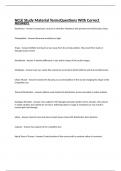
-
NCLE Study Material TermsQuestions With Correct Answers
- Exam (elaborations) • 10 pages • 2023
- Available in package deal
-
- $10.99
- + learn more
Strabismus - Answer Crossed eyes, muscle or refractive imbalance that prevent normal binocular vision. Photophobia - Answer Abnormal sensitivity to light Tropia - Answer Definite turning of an eye away from its normal position. May result from weak or damage ocular muscle Aniseikonia - Answer A relative difference in size and/or shape of the ocular images Amblyopia - Answer Lazy eye, vision that cannot be corrected to 20/20 with the aid of prescribed lenses Ciliary Muscle - Answer...
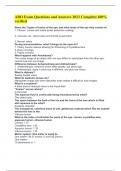
-
ABO Exam Questions and Answers 2023 Complete;100% verified
- Exam (elaborations) • 3 pages • 2023
-
- $9.48
- + learn more
ABO Exam Questions and Answers 2023 Complete;100% verified Name the 3 types of tunics of the eye, and what areas of the eye they consist of. 1. Fibrous: cornea and sclera (outer protective coating) 2. Vascular: iris, ciliary body and choroid (uveal tract) 3. Neural: retina During accommodation, what 3 things do the eyes do? 1. Ciliary muscle relaxes allowing for thickening of crystalline lens 2. Eyes converge 3. Pupils constrict What happens with Aniseikonia? The ocular image of ...
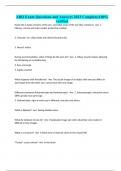
-
ABO Exam Questions and Answers 2023 Complete;100% verified
- Exam (elaborations) • 5 pages • 2023
-
Available in package deal
-
- $10.99
- + learn more
ABO Exam Questions and Answers 2023 Complete;100% verified Name the 3 types of tunics of the eye, and what areas of the eye they consist of. -Ans 1. Fibrous: cornea and sclera (outer protective coating) 2. Vascular: iris, ciliary body and choroid (uveal tract) 3. Neural: retina During accommodation, what 3 things do the eyes do? -Ans 1. Ciliary muscle relaxes allowing for thickening of crystalline lens 2. Eyes converge 3. Pupils constrict What happens with Aniseikonia? -Ans The...
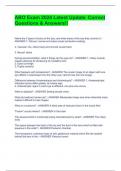
-
ABO Exam 2024 Latest Update Correct Questions & Answers!!
- Exam (elaborations) • 4 pages • 2024
-
Available in package deal
-
- $9.99
- + learn more
Name the 3 types of tunics of the eye, and what areas of the eye they consist of. - ANSWER 1. Fibrous: cornea and sclera (outer protective coating) 2. Vascular: iris, ciliary body and choroid (uveal tract) 3. Neural: retina During accommodation, what 3 things do the eyes do? - ANSWER 1. Ciliary muscle relaxes allowing for thickening of crystalline lens 2. Eyes converge 3. Pupils constrict What happens with Aniseikonia? - ANSWER The ocular image of an object with one eye differs in ...

-
ABO advance study guide Accurate 100%
- Exam (elaborations) • 38 pages • 2024
-
Available in package deal
-
- $12.99
- + learn more
When taking seg height measurements, which of the following situations could result in a parallax error? - ANSWER Patient sitting/ dispenser standing erect Which of the following is not significant in identifying the problem of vertical imbalance? - ANSWER Patient's age Which of the following elements is NOT critical when determining vertical imbalance? - ANSWER Lens power in the 180 degree meridian A prism will displace the object being viewed towards its ________. - ANSWER Apex A ...

-
ABO ADVANCE STUDY GUIDE (QUESTIONS AND ANSWERS) 2024 UPDATED
- Exam (elaborations) • 40 pages • 2024
- Available in package deal
-
- $17.99
- + learn more
ABO ADVANCE STUDY GUIDE (QUESTIONS AND ANSWERS) 2024 UPDATED When taking seg height measurements, which of the following situations could result in a parallax error? - CORRECT ANSWER-Patient sitting/ dispenser standing erect Which of the following is not significant in identifying the problem of vertical imbalance? - CORRECT ANSWER-Patient's age Which of the following elements is NOT critical when determining vertical imbalance? - CORRECT ANSWER-Lens power in the 180 degree meridian...
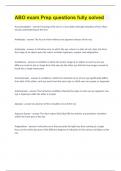
-
ABO exam Prep questions fully solved
- Exam (elaborations) • 5 pages • 2023
-
Available in package deal
-
- $14.49
- + learn more
Accommodation Focusing of the eye in a near object theough relaxation of the ciliary muscle and thickening of the lens. Amblyopia The loss of vision without any apparent disease of the eye. Ametropia A refractive error in which the eye, when in a state of rest, does not focus the image of an object upon the retina, includes hyperopia, myopia, and astigmatism Aniseikonia A condition in which the ocular image of an object as seen by one eye differs so much in size or shape...
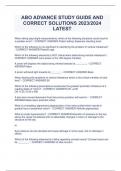
-
ABO ADVANCE STUDY GUIDE AND CORRECT SOLUTIONS 2023/2024 LATEST
- Exam (elaborations) • 40 pages • 2023
-
Available in package deal
-
- $17.99
- + learn more
ABO ADVANCE STUDY GUIDE AND CORRECT SOLUTIONS 2023/2024 LATEST When taking seg height measurements, which of the following situations could result in a parallax error? - CORRECT ANSWER-Patient sitting/ dispenser standing erect Which of the following is not significant in identifying the problem of vertical imbalance? - CORRECT ANSWER-Patient's age Which of the following elements is NOT critical when determining vertical imbalance? - CORRECT ANSWER-Lens power in the 180 degree meridi...
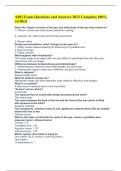
-
ABO Exam Questions and Answers 2023 Complete;100% verified
- Exam (elaborations) • 3 pages • 2023
-
- $9.49
- + learn more
ABO Exam Questions and Answers 2023 Complete;100% verified Name the 3 types of tunics of the eye, and what areas of the eye they consist of. 1. Fibrous: cornea and sclera (outer protective coating) 2. Vascular: iris, ciliary body and choroid (uveal tract) 3. Neural: retina During accommodation, what 3 things do the eyes do? 1. Ciliary muscle relaxes allowing for thickening of crystalline lens 2. Eyes converge 3. Pupils constrict What happens with Aniseikonia? The ocular image of ...
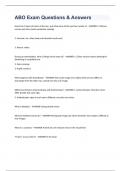
-
ABO Exam Questions & Answers
- Exam (elaborations) • 5 pages • 2023
-
- $7.99
- + learn more
ABO Exam Questions & Answers Name the 3 types of tunics of the eye, and what areas of the eye they consist of. - ANSWER-1. Fibrous: cornea and sclera (outer protective coating) 2. Vascular: iris, ciliary body and choroid (uveal tract) 3. Neural: retina During accommodation, what 3 things do the eyes do? - ANSWER-1. Ciliary muscle relaxes allowing for thickening of crystalline lens 2. Eyes converge 3. Pupils constrict What happens with Aniseikonia? - ANSWER-The ocular image of an...

Study stress? For sellers on Stuvia, these are actually golden times. KA-CHING! Earn from your study resources too and start uploading now. Discover all about earning on Stuvia


